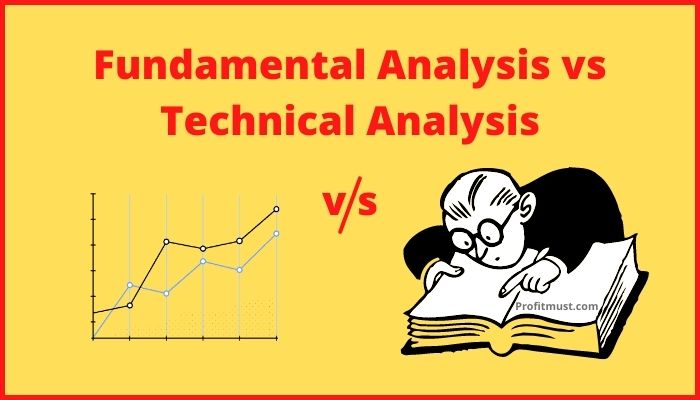As things are changing in the stock market day by day, investors are focusing more on proper analysis before buying or selling any stock. There are two kinds of analysis which every pro trader advises beginners : fundamental analysis and technical Analysis.
In this post we will discuss meaning of fundamental analysis and what are the major tools for Fundamental Analysis:
Table of Contents
What is Fundamental Analysis?
Fundamental analysis examines a company’s financial health at the most essential levels. It looks at a company’s major ratios to see if the stock’s current price is cheap or overvalued.
It also forecasts the stability and growth possibilities of the company. Fundamental analysis is essential for an investor. It supports him in determining the value of a company.
Major Elements of Fundamental Analysis
The following elements are considered in fundamental analysis:
- Firm’s financial reports
- Working style of the management
- Asset allocation
- Popularity of the product
- Firm’s press briefings
- Global outlook of the industry
- Trade contracts
- External policies of the nation
- Media reporting about the company
- Competitor companies analysis
There is an investing opportunity if the present price of the share differs from market opinions and fundamental reasons, as revealed by the research.

Need of tools for Fundamental Analysis
Before looking at other factors, the most important data point to look at is a company’s earnings. Profitability represents one firm’s earnings.
Every quarter, most firms declare their earnings, which are closely inspected by all analysts. Earnings have a big influence on stock values. Share prices are expected to rise if a company declares an increase in profits.
Share values are likely to be damaged if the company fails to meet earnings projections. Rich dividends can be earned from a firm’s good earnings.
Revenues alone don’t tell you anything about how the stock will be valued in the market. For a thorough investigation, you’ll need to employ tools for fundamental analysis.
Tools for Fundamental Analysis
The following are nine most popular Tools for Fundamental Analysis:
Earnings per share or EPS
The amount of profit allocated to each share of the firm is referred to as EPS. It’s computed by dividing the firm ‘s overall income or profit by the total number of outstanding stocks.
To put it another way: EPS = Net income of the firm after tax / total number of outstanding equities. As EPS is a measure of a company’s health, a higher EPS indicates higher investment returns.
Basic and diluted EPS are both acceptable. The basic EPS measures total outstanding shares, whereas the diluted EPS measures shares held by the firm as well as those that may be issued to investors in the future.
-
Type of EPS & how to Analyze it?
Aside from that, EPS can be separated into three categories: trailing, current, and forward. A trailing EPS is the actual EPS for the most recent fiscal year.
A current EPS is the current fiscal year’s project EPS. The forward EPS is a forecast of the company’s earnings for the coming fiscal year.
The EPS of one firm can be examined to the EPS of another firm in the same industry to determine which one to invest in.
Nevertheless, in order to return back to normal, a higher EPS may result in lower earnings or falling stock prices.
-
Example of EPS fundamental tools
Despite making a profit, a firm’s EPS may be lower. For example, if a corporation earns 10 lakh rupee and has 25,000 shares outstanding, their EPS is 1000000/25000 = 40.
An EPS of 25 will be earned by a business that generates Rs 20 lakh and has 80,000 shares outstanding. As a result, although the second firm earns a bigger profit, the first entity with a higher EPS is more certain to reward investors with a higher profit.
Price to earnings ratio or P/E
Among the most important tools for fundamental stock analysis is the price-to-earnings ratio (P/E). It shows the firm’s payouts in relation to the stock price. You can use this to determine whether a stock is profitable for the amount you pay.
The P/E ratio is derived by dividing the stock price by the earnings per share (EPS). If a firm ‘s stock price is Rs 100 and its earnings per share (EPS) is Rs 20, the P/E ratio is 5.
In comparison to the share price, a lower P/E ratio indicates the prospect of larger earnings. A low P/E ratio could indicate a lower price per stock in comparison to earnings.
This indicates that the share is undervalued and has the ability to rise in value over time. A higher P/E ratio, on the other hand, has the opposite effect.
-
How to analyze it?
The P/E ratio can be classified as follows:
1. The trailing P/E ratio is the P/E ratio for the previous 12 months.
2. P/E ratio for the future 12 months (forward P/E ratio).
There may be a drop in earnings if the forward P/E ratio is larger than the following one. If the forward P/E ratio is lower than the trailing P/E ratio, the company’s earnings may improve.
The importance of the P/E ratio varies depending on the investor. The price-to-earnings ratio (P/E ratio) indicates how much you are willing to pay for a company’s earnings. One’s intention to invest may differ from that of another investor.

Return on Equity
The RoE measures a company’s ability to create profits from its shareholders’ investment. Divide net earnings after taxes by shareholders’ equity to arrive at this value. If the company made Rs 80 lakh this year and has Rs 4 lakh in shareholders’ equity, the ROE is 8000000/ 400000 = 20%.
The ROE is measured in percentages. A higher ROE indicates a more efficient business. It implies that the company’s profitability can be increased without the need for new money.
A company with less assets, on the other hand, can have a greater ROE. As a result, not every company with a higher ROE is fit for investment.
It’s best to compare the returns on investment of companies in the same industry. A ROE of 13 to 15 is regarded as good.
Price to book or P/B Ratio
The price to book ratio compares the book value of a stock to its market value. The cost of each asset is subtracted from its cumulative depreciation to arrive at its book value.
Divide the most recent closing price by the prior quarter’s book value per share to get the P/B ratio. It shows us what the firm will be left with if all of its liabilities are paid off and all of its assets are liquidated.
If it’s less than one, the stock is considered undervalued. If there are more than one, the stock is considered expensive.
The P/B ratio is critical because it determines whether a company’s assets are equivalent to its stock market valuation. Firms having larger liquid assets, such as insurance, banking, and investing, have a higher ratio.
Beta
The Beta is a measure of how closely a stock’s price relates to its industry. The Beta can be calculated by comparing the stock to a benchmark index. Most of the time, the Beta oscillates between -1 and 1.
It can, nevertheless, have a value that is higher or lower than this threshold. Any beta number greater than zero indicates that the stock is correlated to the benchmark index.
Beta values less than 0 indicate that shares are inversely connected. A higher beta indicates higher volatility, which indicates greater asset risk. The smaller the Beta, the less volatile the investment.
Price to sales ratio
The price-to-sales ratio compares the price of a company’s stock to its revenue. The P/S ratio can be calculated by dividing market capitalization by income or by using the following formula:
The P/S ratio : price per share of stock divided by the revenue per share.
Undervaluation is indicated by a lower P/S ratio, whilst overvaluation is shown by a P/S ratio above average. A lower P/S ratio is preferred since it indicates that investors are willing to pay less for each sale unit.
The shortcoming of this indicator is that it does not account for the company’s expenses and debt. As a result, a business with a higher P/S ratio may be unprofitable.
Dividend Payout Ratio
The dividend payout ratio tells us how much money the firm has made and how much of it is paid out in dividends. It is computed by dividing the total dividend amount by the firm ‘s net income.
As there may be little possibility for expansion, a corporation can choose to disperse its profit as a dividend.
The dividend payout ratio measures how much money a corporation keeps for future growth, debt repayment, and cash reserves.
Dividend Yield Ratio
Next in the list of tools of Fundamental analysis is the dividend yield ratio. It measures how much a firm pays out in dividends in relation to its stock price. Divide the annual dividend of a stock by the current share price to get the dividend yield ratio presented in percentage figures.
For investors wishing to earn dividends from a firm, the dividend yield ratio is critical. This fundamental research metric is not available for all companies because not all companies pay dividends.
Some businesses keep their profits to invest in future expansion.
Projected earnings growth Ratio
Earnings growth projections show how much you’ll have to pay for each unit of the firm’s future earnings growth. It’s computed by multiplying the P/E ratio by the expected sales growth.
With lower expected earnings growth, the amount paid for each unit of future earnings growth will be smaller. A business with a lower PEG ratio is basically stronger since its earnings are expected to expand faster.
Usually, investors avoid stocks with a higher PEG ratio.

How to Use Tools for Fundamental Analysis?
Some of these ratios can be found on BSE or NSE website. Remember that these figures are just that: tools. There is no single ratio or metric that will provide you with all of the information you require. They are unable to provide you with buy or sell recommendations on their own.
They need to be weighed alongside other factors. These metrics can act as benchmarks to assist you evaluate and analyze different firms as you develop a picture of what you want in an investment.
Every trader and investor in the stock market has their own set of tools for fundamental analysis which they use to make buy and sell decisions.
Conclusion
A detailed fundamental analysis of a stock is not possible for all investors. Applying fundamental analysis tools, on the other hand, will benefit in the close and correct monitoring of stocks.
This is all from our side regarding Tools for Fundamental Analysis.Let us know your views about fundamental tools in the comment section.
Other Interesting blogs related to Tools for Fundamental Analysis:
Techniques of Financial Statement Analysis
Best technical analysis app for Indian stock market
Books on Technical Analysis of Indian Stock Market
Frequently Asked Questions About Best Fundamental Analysis Tools
What are the methods of fundamental analysis?
Fundamental analysis determines a firm's underlying value and potential for future growth by looking at its revenues, profits, future growth, return on equity, profit margins, and other statistics. The financial statements of a firm contain all of this information.
What are the 3 layers of fundamental analysis?
Economic analysis is the first of three layers of fundamental analysis. The other two are analysis of the industry & Analysis of the business.
How do you analyze a fundamental analysis?
The following are the six phases to performing fundamental analysis on equities, as mentioned by the author: For preliminary screening, use financial ratios. An understanding of the company is essential. Examine the company's financial statements. Examine the debt and warning signals. Research the company's rivals. Examine the prospects for the future.
Which site is best for fundamental analysis?
The Major popular websites are Moneycontrol, Screener, NSE India and BSE Website.
What are the five steps of fundamental analysis?
Here are the five major steps : Economic and Market Analysis, Analysis of Financial Statements, Forecasting relevant payoffs, Formulating a security value, Making a recommendation.

